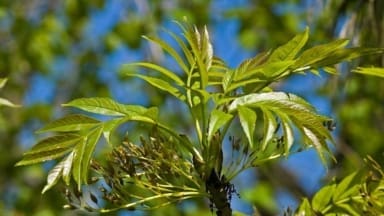
The Living Ash Project seeks out healthy ash (Fraxinus excelsior) trees within ash dieback diseased woodlands across Britain and grafts these resilient trees, which are eventually planted out as the National Archive of Tolerant Ash.
The project, funded by Defra runs until August 2024, is run as a cross-agency research project by Future Trees Trust, Forest Research, Royal Botanic Gardens, Kew and Fera.
The first phase, completed in 2018, involved the screening and selection of ash for resistance. In addition to the work by the partners on the project, citizens assisted by looking for trees in the wider environment. Approximately 1000 trees identified with tolerance to ash dieback, grafted and planted out on the public forest estate in 2019.
The project, now in its second phase concerns the testing of Ash selections using chemical fingerprinting and controlled inoculations to quantify tolerance of Hymenoscyphus fraxineus, as well as developing new propagation techniques, securing tolerant material for seed production and adding more tolerant trees to the archive.
May 2024 updates
- Forest Research assessed six mass screening trials established in 2013, and the three progeny trials established in 2016 since phase 1
- Future Trees Trust has assessed many research trials that constituted the breeding programme before the arrival of Hymenoscyphus fraxineus. They identified a further 790 trees during with tolerance to ash dieback during 2023 and grafted over 5,000 ramets for inclusion in the National Archive in Hampshire in January 2024, including additional grafts for a second archive to be located in Scotland.
- Forest Research completed work on controlled inoculations to test tolerance of selections via (1) direct inoculation through infected wood inserted in to the main stem of young grafted clones, and (2) through a spore suspension placed on leaves (more natural infection mechanism). Both inoculations worked, with clones being identified as tolerant and susceptible performing as expected. In addition to this, they have tried to isolate the fungus from wood samples taken from trees with healed lesions, and were unable to detect the pathogen – an indication that the tree is somehow combating the disease. These trees are of particular interest to the project as though they have come in to contact with ash dieback, they are only surviving, growing well and putting on increment.
- Royal Botanic Gardens, Kew tried various different cutting techniques (timing of taking cuttings, hormone treatment, age of material) but were unable to get cuttings to root except in the very youngest of seedlings (1 – 2 years old). Tolerant selections were subsequently grafted again. Propagating ash reliably from cuttings remains elusive, as it does for oak too.
- Selections will also be tested through liquid chromatography mass spectroscopy to identify individual chemicals that are associated with tolerance. Fera will be undertaking this work during summer 2024.

